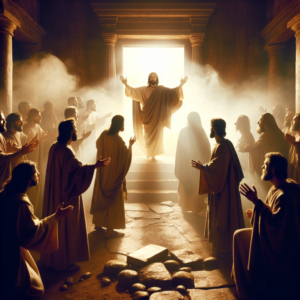Spiritual Devotional about Spiritual Symbols in Nature
Unpacking Spiritual Symbols in Nature
The beauty of nature often leaves us in awe and contemplation. From the grandeur of towering mountains to the serene tranquility of gently flowing streams, each natural element symbolizes a significant spiritual truth that speaks volumes about the divine. Embracing these manifestations allows us to cultivate a deeper connection with God and understand His eternal truths in a profound way.
The Tree of Life
The tree, a recurring symbol in the Bible and many other spiritual texts, often embodies strength, wisdom, and the interconnection of life. In the Biblical context, the Tree of Life in the Garden of Eden (Genesis 2:9) represents eternal life. As believers “root” themselves in their faith (Colossians 2:7), they grow spiritually, standing tall and unshakeable, just like a tree firmly planted in the ground.
Mountains as Sacred Spaces
Mountains are often cited as places of divine connection, spiritual revelation, and prayer in the Bible. Moses received the Ten Commandments on Mount Sinai, and Jesus often retreated to mountains for prayer (Mark 6:46). Just as mountains stand unchanging against the backdrop of changing seasons, so too does God’s love and truth remain constant amidst our changing lives.
Water as a Symbol of Purification and Life
Water, especially in the context of rivers and streams, is often associated with purity, renewal and life. When Jesus was baptized in the River Jordan (Matthew 3:13-17), water’s symbolism took on a powerful new meaning: new life and purification from sin.
The Significance of Birds
The Bible uses birds to symbolize different spiritual concepts. The dove often symbolizes the Holy Spirit, as seen at the Baptism of Jesus (Matthew 3:16), while the eagle represents strength and hope with wings of faith, as beautifully depicted in Isaiah 40:31.
The Power of Light
Sunlight, as the purest form of light, illuminates the world around us. It stands as a powerful symbol of God’s illuminating presence and divine truth (Psalms 27:1). When we walk in spiritual light, we can shun the darkness of ignorance, sin and fear.
The Lessons from Seasons
Seasons that bring about change in nature is a symbol of the different seasons in our personal spiritual journeys. Just as winter brings dormancy and spring brings new life, we too, go through periods of spiritual dormancy and spiritual reawakening. Ecclesiastes 3:1 reminds us that there’s a time for everything, and every season under heaven hast its own divine purpose.
Each of these symbols in nature helps us delve deeper into our spiritual journey, giving us fresh insights. As we contemplate on these symbols and their deeper meanings, we learn to see God’s fingerprints in the grandeur and beauty of the natural world. Our perspective changes, and we can appreciate our relationship with our Creator in new, profound ways.
Nature truly is God’s canvas, filled with spiritual symbols that serve as gentle, ever-present reminders of His love, His promises, and His eternal truths. So let’s set an intention to embrace the beauty of nature in a more mindful and spiritually aware manner.
Explore and dig up answers yourself with our BGodInspired Bible Tools! Be careful – each interaction is like a new treasure hunt… you can get lost for hours 🙂
Q&A about Spiritual Symbols in Nature
Q: What are some common spiritual symbols found in nature?
A: Common spiritual symbols found in nature include the lotus flower which represents spiritual enlightenment in Buddhism, the cross which is used in Christianity to symbolize the sacrifice of Jesus Christ, and the tree of life which is a sacred symbol in many cultures representing growth, healing, and strength.
Q: What does the lotus flower symbolize in Buddhism?
A: In Buddhism, the lotus flower symbolizes spiritual enlightenment and rebirth. The trait of the lotus flower blooming through muddy waters signifies achieving purity and wisdom from human’s trials and tribulations.
Q: What does the cross symbolize in Christianity?
A: In Christianity, the cross symbolizes the sacrifice of Jesus Christ for the sins of humanity. It also represents faith, resurrection, and eternal life.
Q: How does the tree of life represent growth and strength?
A: The tree’s deep roots symbolize strong foundation and stability, its trunk denotes strength, the branches signify growth and reaching out towards nourishment and light – symbolic for enlightenment and transformation, and finally the leaves and fruits speak for nourishment and the cycle of life.
Q: Are there any spiritual symbols related to animals in nature?
A: Yes, many animals also hold spiritual significance in different cultures. For example, the eagle represents spiritual protection, freedom and strength in various Native American cultures, while the butterfly is often seen as a symbol of transformation, hope and life after death.
Q: How do natural elements like water, fire, earth, and air symbolize spiritual concepts?
A: In many spiritual beliefs, water represents purification, healing, and transformation; fire symbolizes passion, transformation, and rebirth; earth is associated with fertility, abundance, and stability; and air pertains to intellect, freedom, and communication.
Q: Can man-made structures also be considered spiritual symbols in nature?
A: Absolutely, many man-made structures are created with spiritual symbolism in mind and become integrated into natural landscapes. Some examples include ancient stone circles or monuments like Stonehenge, or religious buildings like churches, temples, or megaliths.
Q: What does the serpent symbolize in spiritual concepts?
A: The serpent, or snake, is a powerful spiritual symbol in many cultures. In Christianity, it’s often associated with sin and temptation. In many Indigenous cultures, it represents wisdom, power and protection. Also, in Hinduism, it’s linked with kundalini energy – the spiritual energy within a human.


